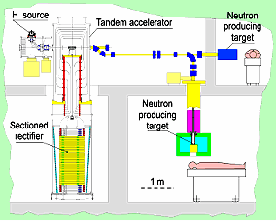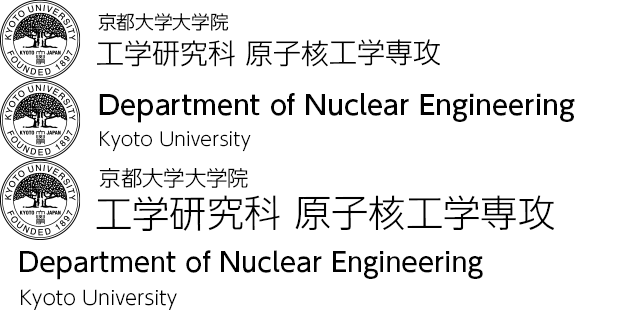Radiation Medical Physics
Various kinds of radiation as high energetic photon, high energetic heavy ion and neutron are used for clinical use. It is most important problem to definite high dose region of radiation to a target volume (tumor) for therapy use and to decrease exposure dose for diagnosis use. We study to develop optimal irradiation field for clinical use of radiation (especially, heavy charged particle and neutron) on quality assurance of it.
As to studies related to neutron capture therapy, the topics of the field of physics and engineering related to neutron irradiation system have been majoring.In particular,
- design of neutron irradiation system for medical care with a nuclear reactor and an accelerator,
- development of an online dose measurements and its evaluation system during neutron irradiation, are current important subjects.
Academic Staff
Hiroki TANAKA
Professor (Institute for Integrated Radiation and Nuclear Science)
Research Theme
Contact Information
TEL: +81-724-51-2468
FAX: +81-724-51-2620
E-mail: h-tanaka@* (Add "rri.kyoto-u.ac.jp" after @)
Yoshinori SAKURAI
Associate Professor (Institute for Integrated Radiation and Nuclear Science)
Research Theme
- Engineering and medical physics for radiation therapy, mainly boron neutron capture therapy (BNCT)
- Development and improvement of neutron irradiation system and dose estimation system for mix field of neutron and gamma-ray
- Advancement of dose planning simulation method, and establishment of quality assurance/quality control (QA/QC) procedure for BNCT
Classes
Radiation Medical Physics, Radiation Measurement for Medicine
Contact Information
Research Reactor Institute, Laboratory Build. 1F Room 3
TEL: +81-72-451-2306
E-mail: yosakura@* (Add "rri.kyoto-u.ac.jp" after @)
Takushi TAKATA
Assistant Professor (Institute for Integrated Radiation and Nuclear Science)
Research Theme
Contact Information
TEL: +81-72-451-2337
FAX: +81-72-451-2658
E-mail: taku-takata@* (Add "rri.kyoto-u.ac.jp" after @)
Research Topics
Development of compact beam delivery system for clinical use of H and He beams
In resent years, high energetic light charged particles as proton (H) and helium (He) from an accelerator play an important role in the field of the radiation therapy. The primary charged particle can directly ionize atoms and/or molecules in the materials due to the charged-charge interaction and generate neutrons as a result of nuclear reactions with atoms. A charged particle can give its effect as the biological damage on the definite region in the target material by its characteristic dose distribution shown as a Bragg curve. Furthermore, these light ions are low LET (linear energy transfer) radiations same as X-rays used as main radiation for the cancer therapy during about one hundred years. So, we can use all data and experience accumulated on the X-ray radiation therapy for the light ion therapy. For the charged particle cancer therapy, a beam delivery system together with an accelerator and beam transport system. The devices compose the beam delivery system are the beam range changer, the range modulator, the flattening filter, the range modulator, the energy compensator and so on. It is important to develop these devices and to rearrange the system from a point of view of conformity of a high dose region with a target region (tumor), convenience, economy and safety.
On the other hand, neutrons as a secondary particle can ionize indirectly only. On the neutron cancer therapy, charged particles generated as results of interaction between neutrons and nuclei have generally small kinetic energy. So, neutrons are high LET radiation have large biological effect. Fast neutron and thermal neutron are also used for the cancer therapy. Main reaction of fast neutron and thermal neutron used for therapy are elastic scattering and nuclear reaction, respectively. Phenomena as a result of reaction between thermal neutron and particular kinds of nuclei as 6Li and 10B are very attractive for cancer therapy. If it is possible to accumulate a drug (compound) labeled by these nuclei in the tumor, the tumor within the normal tissue can be selectively eradicated. The therapy with thermal neutron and 10B is called as Boron Neutron Capture Therapy (BNCT). At present, nuclear reactor is used as thermal neutron source. We study characteristics of neutron field generated from s target when an accelerator is used as neutron source for future.
Development of verification system of energy- and dose- distributions of light ion (H and He) beams for clinical use.
It is essential problem for conformal therapy and quality assurance of particle therapy by charged particle beam to develop beam monitor in a patient body and 2 and/or 3 dimensional dose distribution detector.
Main subjects relating to this theme are
- to measure of dose distribution in a tissue equivalent phantom at the isocenter
- to verify directly and indirectly dose distribution in a patient body and to control dose given to a target
- to verify directly and indirectly a position of a target in a patient body
- to verify reproducibility of patient positioning..
To carry out these, it is essential to improve a treatment planning system.
Development of neutron irradiation field and online dose measurement and its evaluation system for medical care with an accelerator
History seems to show that medicine has been quick in adapting to newly invented technology. This is especially true for the field of radiological physics which serves as a bridge between engineering physics and medicine with the former giving priority to the acquisition of fundamental physical knowledge and the latter on the preservation of human life.
Neutron Capture Therapy (NCT) is known as one of the radiation therapy modalities that are effective for brain tumor and malignant melanoma because of its characteristics of being able to treat cancer cells selectively. The central theme of researches in the field of engineering physics related to NCT is strongly related to selective cancer treatment. From 1968 to 1994, Japan was the only country that carried out NCT for malignant tumor. The fundamental researches based on clinical trials performed during this period have led to the development of the field of engineering physics related to NCT in Japan.
Since 1969, Kyoto University Research Reactor Institute has produced researches in line with practical medical applications. Among these are studies on low mixture of gamma rays thermal neutron irradiation field, shielding materials for thermal neutron field with low secondary gamma rays, an evaluation method for the estimation of cell level absorption energy, and a method for measuring 10B concentrations by prompt gamma rays. Their results have been reported in various scientific meetings and have been published in related journals. Based on these researches, the KUR heavy water thermal neutron facility has been remodeled in 1996 for medical irradiation.
Current researches are directed at
- the development of online dose measurement for NCT evaluation system using prompt gamma rays (PG-SPECT system) and
- the design of an accelerator-based neutron irradiation system and the construction of its prototype.
The latter aims to develop a source of neutron irradiation fields for medical use with both compactness and convenience of a hospital-based system in mind. With this system, two kinds of irradiation fields are possible, namely, a moderator type and the use of direct neutrons from 7Li(p,n)7Be near threshold reaction.

Figure 1:An example of irradiation system for neutron capture therapy with tandem accelerator
(Russian suggestion)

Figure 2:An online dose measurement evaluation system (a PG-SPECT system)
Development of the novel neutron irradiation system for NCT
The neutron irradiation fields using research reactors have been utilized in neutron capture therapy (NCT) for malignant brain tumors and malignant melanoma, since the first NCT was carried out in the U.S.A. in 1951. The neutron irradiation fields using accelerator has been studied and designed from the beginning of 1980's. It has not yet put to practical use, because of some technical limitations in accelerator system. However, I think it will be realized near future, as the recent innovation in the accelerator technology is remarkable.
In the Heavy Water Neutron Irradiation Facility at the Kyoto University Reactor (KUR), the NCT clinical trial has been performed regularly from 1990. The trial for oral cancers started in 2001, initiatively in the world. Additionally, we are planning the wider application for the other cancers, such as liver, pancreas, lung, tongue and breast cancers.
Based on theses matters, I think that the concepts of the novel neutron irradiation system for NCT are as follows;
- accelerator-base neutron irradiation field, which can be installed near a hospital.
- variable-energy-spectra irradiation field, in order to control the dose distribution in a human body. And,
- the proactive utilizations of multi-directional and/or multi-divisional irradiations.
Concurrently, the irradiation system of "hyper-thermal neutrons", which has an energy spectrum of the Maxwellian distribution with a few thousands Kelvin, has been studied.

